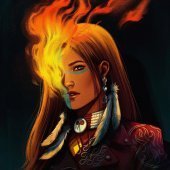Search the Community
Showing results for tags 'textures'.
Found 4 results
-
Unfortunately, using a patch to make one thing better will make other things worse. This patch fixes dragon objects that end up broken by dragon patches. (my own included!) Objects like Dragonmaw trophies, the wall-mounted dragon head, Twilight butchered dragons, and dragons hanging from the ceiling in Blackwing Descent are all fixed by this patch, which changes those objects to use textures in this patch instead of from the game itself. It introduces versions of those objects whose textures are assigned to custom IDs, therefore avoiding conflicts with patches and existing textures altogether. Download here and install using the launcher: https://drive.google.com/file/d/1YfljGaHoD9U2RoMXTmGy6lLXaJR3PLe8/view?usp=drive_link Before this patch, using my own patch TheDragonMash: After using this patch, but while still running TheDragonMash:
- 1 reply
-
- textures
- patch patcher
-
(and 1 more)
Tagged with:
-
I am looking for updated modeling tools for blender, cuz looks like all the sites that used to host those, are dead, or close to dead. So if you have any advice, or an archive for blender 2.77 or 2.80. I would be eternally greatful. <3
-
- model edit
- model
- (and 6 more)
-
Slate’s Guide to Texture & Detaildoodad Shifting CONTENTS: 1. Textures 2. Detaildoodads 3. MCCV Shifting 4. Command list 5. Tips If the forum format is hard to read, the prettier version is also found here. 1. TEXTURES ADT textures are divided into diffuse and height. The diffuse layer is the base texture of the map. Height is an overlay layer and only visible when two textures overlap. The maps implemented before MoP typically only have a diffuse layer, so let’s start by looking at those. STEP 1: Find out the ID of the texture you want to swap. The command for this is .world adt texinfo diffuse This can be shortened in a number of ways. I typically type .wo adt texi diff, but the shortest I’ve found to work is .wo a t d Here we have the textures for Burning Steppes. Find out the one you want to change: Let’s go with burningsteppsashcracks - 186936. Write that down. Your ground should currently look like this: STEP 2: Find out the ID of the replacement texture. There are two ways to do this: 1. Go to a zone with the texture you want to use, and use .world adt texinfo diffuse to find out its ID. 2. Look it up with a keyword. The command for this is .lookup tiletexture, or shortened, .lo tilet Use a keyword. Let’s go with “8riv_grass” for now: As you can see, we are getting both diffuse and height textures, since Stormsong Valley is a post-MoP zone. While diffuse and height can be used interchangeably to replace one with the other, I recommend you choose the same kind of texture as the one you are shifting. We’re focusing on diffuse, so let’s choose a diffuse texture, for example 8riv_grass03 - 1671254. If you do replace a diffuse texture with a height texture, it will look shiny. This is because they are less transparent than diffuse textures, and the less transparent a texture is, the more reflective it will be. STEP 3: Time for the actual shifting! The command for this is .phase shift texture map diffuse [Original] [Replacement] You can shorten this to .ph sh tex map dif [Original] [Replacement], or even as short as .ph sh t m d So, in our case, the original ID for burningsteppsashcracks is 186936, and our replacement 8riv_grass03 is 1671254, so our command will look like this: .ph sh t m d 186936 1671254 Let’s try it out. You should get this message: Your ground textures should look like this: If they do, congratulations! You have successfully phase shifted a ground texture. If you need to reset your texture shift, simply use .ph sh tex map dif [Original ID] 0 - this will restore the original texture. A lot of times, finding out which texture and which detaildoodad is which can be difficult, and unfortunately I have no other advice for that than to test things. Trial and error are how I figured it out. Persistence and above all, patience will get you far. This is also why you really should write everything down. Okay, let’s look at height textures. As mentioned before, height textures are not typically found in maps implemented before MoP. Let’s go to Snowblossom Village - since it’s an island expedition map implemented in BfA, it has both height and diffuse layers. The pathway in the village, unchanged, looks like this: First step is to shift the diffuse textures. This is the diffuse texture for the path - let’s change it to a Stormsong cobble road. As you can see, the diffuse texture ID is nearly identical to the height texture ID, just one higher. This is useful if you want to quickly change your chosen diffuse ID to a height ID or vice versa. When you’ve done your diffuse shifting, your tile path should look something like this: You can see that the lines of the 8zul_tile texture are still present - this is because of the height texture being unchanged. The commands are the same for identifying and shifting as with diffuse textures, with the exception being that we’re working with height, so the commands should obviously have “height” in them instead of “diffuse”. So: .world adt texinfo height Again, this can be shortened to something .wo adt texi hei or even .wo a t h Find the ID: Find the replacement - for us, 8riv_cobble. The command is .phase shift texture map height [Original] [Replacement] So, shortened .ph sh tex map hei or .ph sh t m h if you want to go even shorter. For our purposes in Snowblossom, the command should look like .ph sh tex map hei 1591651 1892671 Your pathway should now look like this: If it does, congratulations! You’ve passed this little crash course to texture shifting. Again, patience, persistence, and testing things out will get you far. Feel free to experiment with different things. If you have wow.export, you can tick “show file data IDs” - with these, you can use any texture for phase shifting purposes. Open your textures tab and go wild. Here I’ve shifted “8zul_moss01_512_s.blp” to a spell effect. It might not always work out - but the possibilities are endless. Take a tea/coffee/water/drink of your choice break - we’ll continue with detaildoodads below. 2. DETAILDOODADS So, detaildoodads! In case you don’t know what detaildoodads are, they’re these little pieces of grass that poke out of the ground. Little doodads for detail, if you will. They come in numerous shapes and forms. Experimentation is recommended and, quite honestly, necessary. STEP 1: Identify. The command is .world adt detailinfo As always, you can shorten this. .wo a d is the shortest I’ve found to work. You should get a list like this: Focus on the IDs that list Doodads 1-4 under them. In my experience, the other detailIDs don’t seem to do anything. Let’s shift Detail ID 149908. STEP 2: Find your replacement. Again, there are two ways to find a replacement: 1. Go to a zone with the detaildoodad you want to use, and use the .world adt detailinfo command. 2. Use .lookup detaildoodad with a keyword. Here’s my results for .lo detail 8kul : For fun, let’s use Detail ID 133430 with the shells. STEP 3: Shift! The command is .phase shift detaildoodad map [original] [replacement] So, after inserting our IDs, our command should look like .phase shift detaildoodad map 149908 133430 Your ground should look like this: If it does, congratulations! You’ve successfully shifted some detaildoodads. Detaildoodads are often tricky and it can be difficult to figure out which ID shifts what doodads and, on bigger maps, where they shift. Just like with textures, patience, persistence, and experimentation will get you far. 3. MCCV SHIFTING Do you have pesky colouring baked into the ground you can’t get rid of with normal texture shifting? Fear not, I have a solution! A great example of this is the Twilight Highlands. Purple stuff baked into the ground. The solution is simple: get rid of the MCCV shading. They are usually very black stains on the terrain, and terrain "makeup". It is worth noting that turning them off will also likely make terrain look flatter and more bland as a result. Our command is .phase shift mccv [adt / map] off. Purple-be-gone. If you want your MCCV lights back on, simply type .phase shift mccv [adt / map] on. 4. COMMAND LIST .world adt texinfo [ diffuse / height ] - Gives you a list of diffuse / height textures present on the map .world adt detailinfo - Gives you a list of detaildoodads present on the map .lookup tiletexture / detaildoodad - Use a keyword to find replacement IDs .phase shift texture map [diffuse / height] [original] [replacement] - Shifts the specified diffuse / height texture on the map to the replacement texture .phase shift texture map [diffuse / height] [original] 0 - Restores the original texture .phase shift detaildoodad map [original] [replacement] - Shifts the specified detaildoodad to the replacement .phase shift detaildoodad map [original] -1 - Removes all of the specified detaildoodad on the map .phase shift detaildoodad map -1 [replacement] - Replaces all detaildoodads on the map with the specified replacement .phase shift detaildoodad map -1 -1 - Removes all detaildoodads on the map .phase shift mccv [adt / map] off - Turns MCCV lights off .phase shift mccv [adt / map] on - Turns MCCV lights on .phase shift mccv [adt / map] reset CONFIRM - Resets MCCV shifts. Requires “CONFIRM” as confirmation - this is case-sensitive 5. TIPS When phase shifting textures and detaildoodads, write everything down. The texture names and IDs, which texture you shift to which. Whether you do this in a digital document or on paper is up to you - though of course a digital document is handier for copying and pasting IDs. It’s much easier to write everything down while doing the shifting than going back afterwards to figure out exactly what texture it was that you used for what. (Though the latter, of course, is possible - just annoying and time-consuming. Speaking from experience, here.) Never use the same replacement ID twice. This will cause errors. This goes for both textures and detaildoodads. This is why you should write everything down - it is very easy to get mixed up with IDs and what’s been shifted to what. The texture ID for the infinite flatlands is 532473. Happy shifting ? This concludes our phase shifting crash course. Good luck, and have fun! Edited to add a bit about MCCV shifting.
-
Hello, one day surfing the internet I found fan arts of Naz'dorei that interested me and well seeing the capacity of this server I wonder if it would be possible to do something like this on the server Example: https://imgur.com/a/oS5zRdN apart from the Nazjatar theme I suppose it would be 10 although of course I don't think many people like the idea but it would be cool
-
- nightborne and night elf
- textures
-
(and 3 more)
Tagged with:

